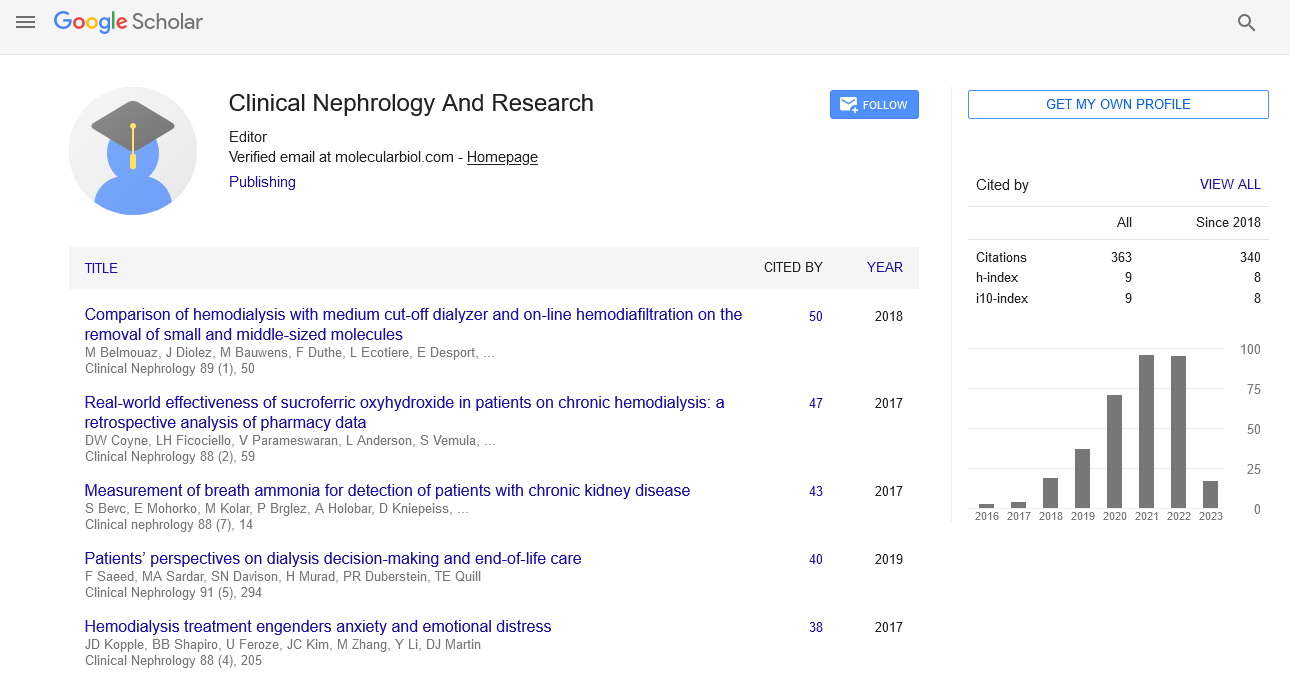The new drug finerenone for patients with type 2 diabetes mellitus and chronic kidney disease
Received: 02-Feb-2024, Manuscript No. PULCNR-24-6007; Editor assigned: 02-Feb-2024, Pre QC No. PULCNR-24-6007 (PQ); Accepted Date: Feb 28, 2024; Reviewed: 11-Feb-2024 QC No. PULCNR-24-6007; Revised: 01-Mar-2024, Manuscript No. PULCNR-24-6007 (R); Published: 01-Mar-2024
Citation: Brown J. The new drug finerenone for patients with type 2 diabetes mellitus and chronic kidney disease. Clin Nephrol Res 2023;7(1):1.
This open-access article is distributed under the terms of the Creative Commons Attribution Non-Commercial License (CC BY-NC) (http://creativecommons.org/licenses/by-nc/4.0/), which permits reuse, distribution and reproduction of the article, provided that the original work is properly cited and the reuse is restricted to noncommercial purposes. For commercial reuse, contact reprints@pulsus.com
Description
1 in 11 adults worldwide, or 463 million people, are believed to have T2DM. Additionally, the rapid development of this condition has led to a high frequency of hypertension and Diabetic Kidney Disease (DKD), the main cause of Chronic Renal Disease (CKD). T2DM and its microvascular effects appear to be influenced by hyperglycemia, low grade inflammation, altered lipid metabolism, and hyper activation of the Renin Angiotensin Aldosterone System (RAAS). The ability to slow the progression of DKD has grown thanks to medications like sodium-glucose cotransporter 2 inhibitors and glucagon like peptide 1 receptor agonists, which have also demonstrated improvements in cardiovascular disease.
The future's most urgent public health concerns are Chronic Kidney Disease (CKD), which places greater demands on healthcare systems' financial and human resource capacities. Additionally, the prevalence of Type 2 Diabetes Mellitus (T2DM) and the high incidence of Diabetic Kidney Disease (DKD) when combined. Hypertension is a crucial factor in the progression of CKD to the end stage. A type of kidney illness called ESKD requires the use of renal replacement therapies. There have been introduced medications like sodium glucose cotransporter 2. With more study, it has become possible to slow the progression of DKD using glucagon like peptide 2 (SGLT-2) enzyme inhibitors and Glucagon like Peptide 1 (GLP-1) receptor agonists. However, renal advancement has not been completely stopped, and the kidney risk still surpasses the benefits in Cardiovascular Disease (CVD).
Due to a clear physiological connection and the fact that mineralocorticoid receptors are present in a variety of tissues, including kidney and heart cells, DKD development is linked to persistent RAAS hyper activation. As a result, the importance of MRAs in affected individuals has been quickly acknowledged by the medical community. They have inhibited these receptors. Both hemodynamic and non-haemodynamic effects result from MRA. As a result, fibrosis and inflammation are diminished, and the development of cardiac renal disease is halted. The most common signs of oxidative stress, inflammation, and renal fibrosis are treated with steroidal MRAs for hypertension, primary aldosteronism, and heart failure. DKD is one of the several causes of CKD endpoints. In both experimental and clinical studies, it has been shown that a number of MRAs improve kidney function. Positive results include reduced renal mortality or doubling of creatinine levels, decreased proteinuria, and no change in estimated GFR (equivalent Glomerular Filtration Rate). Even though more evidence from present and upcoming studies is anticipated, earlier research may provide helpful information. In order to identify the patient's albuminuria lowering drug groups in diabetic and non-diabetic people with CKD, the ROTATE-3 (Rotation for Optimal Targeting of Albuminuria and Treatment Evaluation) trial examines the association between albuminuria and rotation.
The combination of SGLT-2 inhibitors, GLP-1 receptor blockers, and ACE inhibitors has showed promise in the treatment of DKD progression in addition to the conventional usage of RAAS suppression with angiotensin converting enzyme inhibitors or angiotensin receptor blockers. Future trends indicate that agonists and nonsteroidal MRAs will be used more frequently. The kidneys and the heart benefit from the combination of reducing the progression of diabetes with SGLT-2 inhibitors and GLP-1 receptor agonists DKD, which is supported by recent findings in the cardiovascular field. These drugs have been proven to be efficient and to work in concert to lower blood pressure and promote weight loss.
Novel MRAs have demonstrated efficacy in slowing the progression of CKD in diabetic patients. Compared to conventional MRAs, finerenone has a specific side effect and has less of an impact on serum potassium levels. GLP-1 receptor agonists, for the treatment of CKD in persons with type 2 diabetes, exhibit a profile that is comparable to that of SGLT-2 inhibitors. Therefore, joining RAAS is a wise decision. With the aid of cutting-edge hypoglycemic drugs like SGLT-2 inhibitors and GLP-1 receptor agonists, DKD can be treated by addressing a number of significant aspects of the disease's course, including haemodynamics with adequate and secure glycaemic control, dysfunction, inflammation, and fibrosis control. Finally, there is growing evidence that finerenone functions in the cardiac renal system. It is one of the most promising treatments for patients, despite the fact that the field is still developing.





